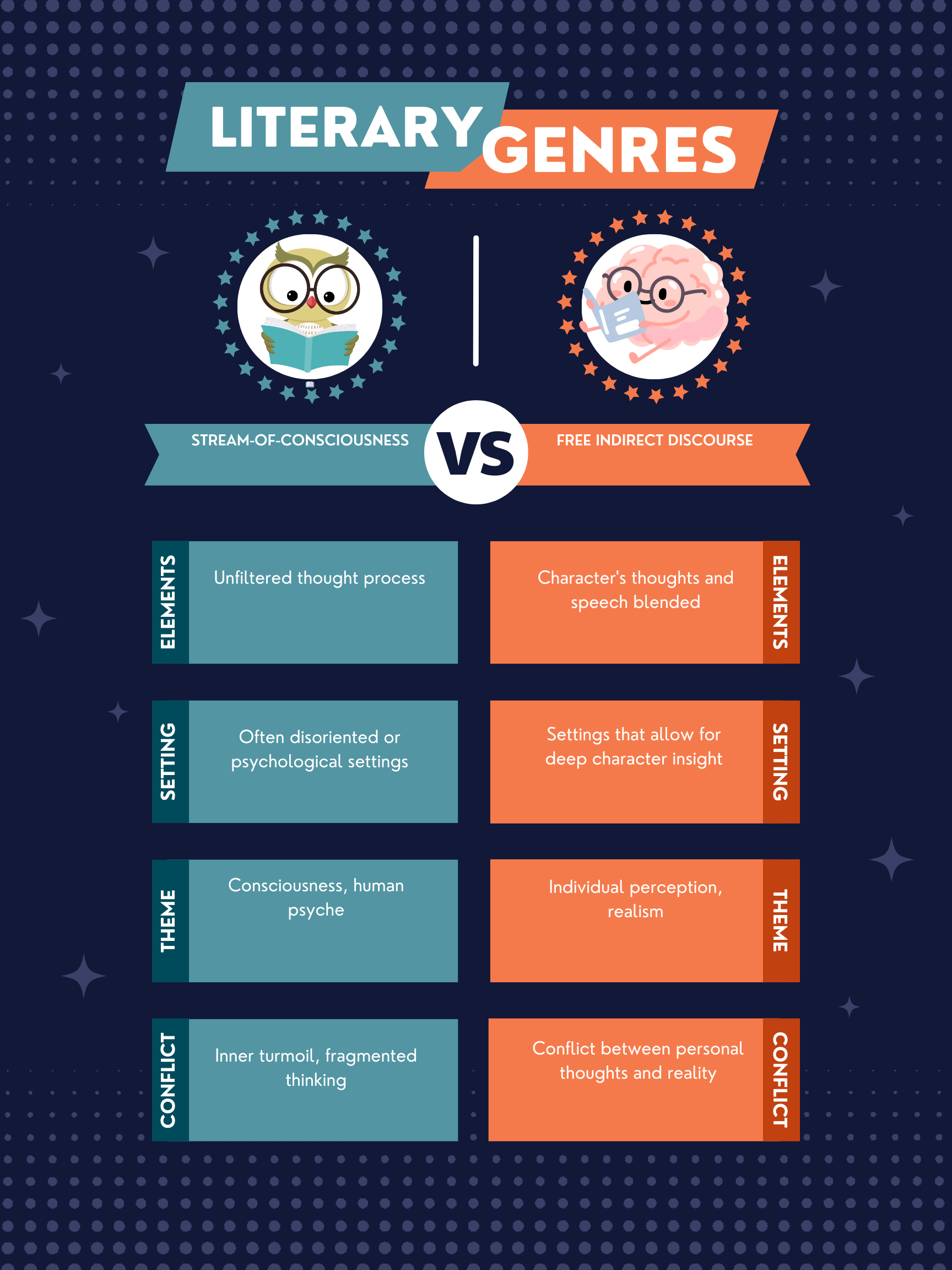Stream of Consciousness presents a character’s thoughts directly as they occur; Free Indirect Discourse blends third-person narration with the thoughts and speech of the characters.
Both stream of consciousness and free indirect discourse are narrative techniques that offer readers a deep, immersive dive into the minds and worlds of characters. By exploring these methods, we can appreciate the nuanced ways authors bring stories to life. 🧠✍️
Stream of Consciousness
Stream of consciousness is a narrative mode that attempts to capture the flow of thoughts running through a character’s mind, often in a disjointed or nonlinear manner. This technique mirrors the way human thoughts and memories weave together in real life. A classic example is James Joyce’s “Ulysses,” where the inner thoughts of characters like Leopold Bloom are presented in a flow that moves from one idea and memory to another, mimicking the natural thought process.
Free Indirect Discourse
Free indirect discourse, on the other hand, blurs the line between the narrator’s voice and the character’s thoughts. It allows readers to hear a character’s voice through the narrative without the constant use of tags like “he thought” or “she said.” Jane Austen’s “Pride and Prejudice” provides instances of free indirect discourse, offering insight into Elizabeth Bennet’s thoughts and feelings, mediated through the narrator’s voice in a way that both personalizes and universalizes her experiences.
Summary
| Literary Device | Definition | Purpose | Usage | Relevant Examples |
|---|---|---|---|---|
| Stream of Consciousness | Presents a character’s thoughts directly as they occur, in a nonlinear flow. | To replicate the natural flow of human thought. | Novels, short stories. | “Ulysses” by James Joyce. |
| Free Indirect Discourse | Blends third-person narration with the thoughts and speech of characters. | To provide intimate character insight without direct quotations. | Novels, short stories, narratives. | “Pride and Prejudice” by Jane Austen. |
Writing Tips
For writers looking to experiment with these techniques, consider the following advice:
- Stream of Consciousness: Let your narrative wander as freely as your thoughts do. Don’t worry about linear structure or clarity in the first draft. Focus on the authenticity of the thought process.
- Free Indirect Discourse: Practice blending your narrative voice with your character’s perspective. This requires a deep understanding of your characters’ minds and how they perceive the world around them.
FAQs
What makes stream of consciousness challenging for readers?
Its nonlinear presentation and lack of traditional structure can be disorienting, requiring readers to piece together the narrative from the protagonist’s thoughts.
How does free indirect discourse affect character development?
It deepens character development by seamlessly integrating characters’ thoughts and feelings into the narrative, enriching the reader’s understanding of their motivations and personalities.
Exercise:
Consider the following excerpt: “He walked through the park, leaves crunching underfoot. Would she be waiting as she promised? The autumn chill reminded him of their first meeting, the way her laughter seemed to dance in the air.”
Answer: This passage uses free indirect discourse, blending the character’s thoughts and sensory experiences with the narrative voice without direct attribution.
Other Interesting Literary Device Comparisons
- Metaphor vs. Simile: Both are figurative language devices used for comparison, but metaphors imply the comparison directly, whereas similes use “like” or “as.”
- First-Person vs. Third-Person Narration: These perspectives differ in the narrator’s position in the story, affecting the reader’s connection to the characters and events.
- Symbolism vs. Allegory: Both imbue narrative elements with deeper meanings, but symbolism does so through objects, characters, or events that represent something else, while allegory uses the narrative itself as a metaphor.
Exploring these devices can enhance both the writing and reading experience, offering new ways to engage with and understand literature. 📚🔍

